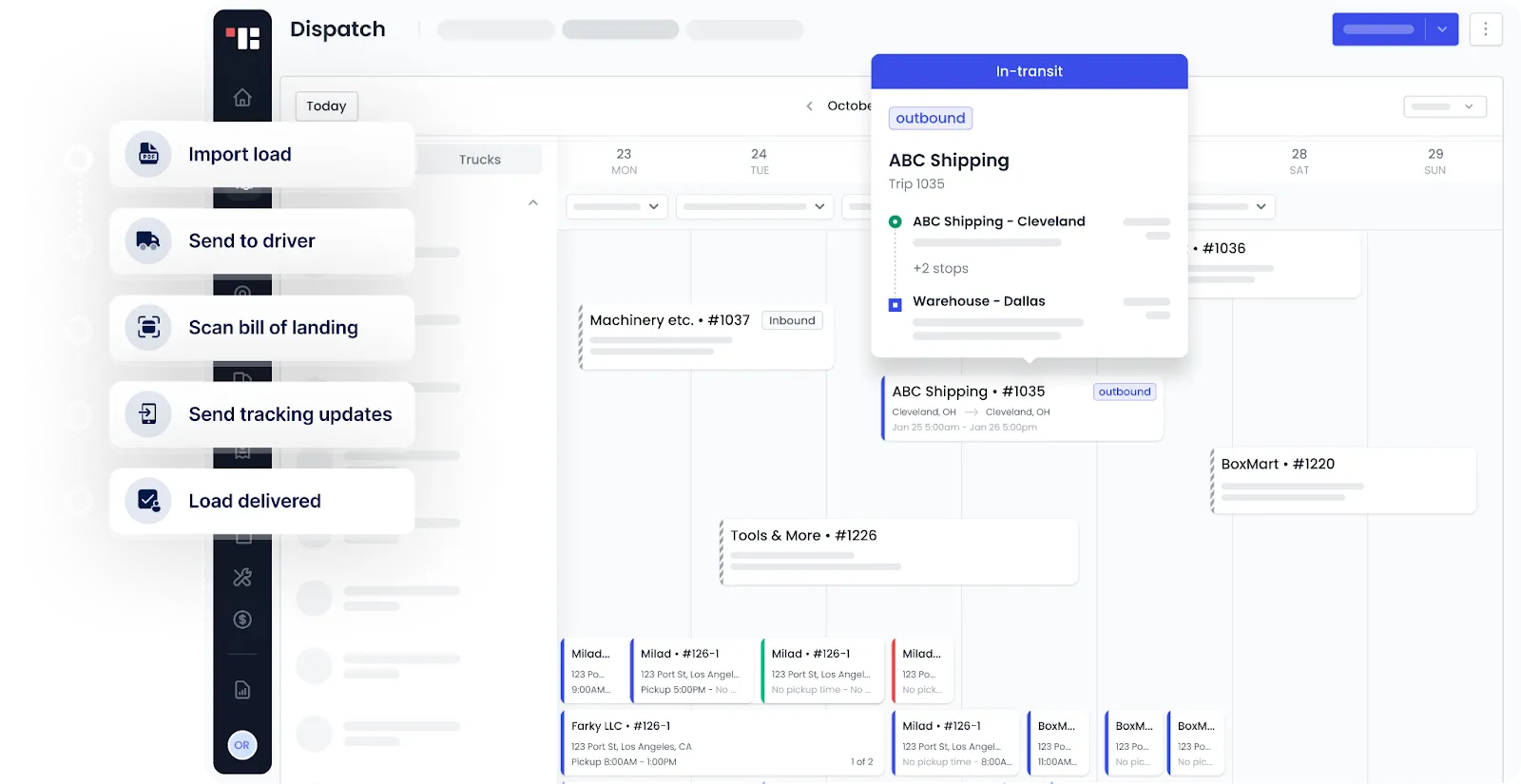As a carrier in today’s market, freight rate pressure and competition make the choice of the right trucking software that much more impactful for your business. Smart carriers view their software tools and technology as extensions and amplifiers of their team – the right software can help eliminate check calls, put on a more professional face with customers and dramatically reduce manual workloads so you can scale your fleet without scaling your headcount.
Not all carriers are created equal, and neither are all trucking software providers. Depending on your fleet size, team makeup, freight type focus, geographic coverage – among many other factors – your choice of software may differ greatly from others.
In this article, we aim to break down the pros and cons of several different leading vendors.
Truckbase: The gold standard for 5-50 truck fleets

If you operate 5-50 trucks, are an asset based carrier running regional or national lanes and want a trucking software solution that is both comprehensive and dead-simple to learn and use, Truckbase is a strong option.
Often the best place to gauge a solution’s potential fit for you by learning from current customers. Truckbase posts customer reviews on its own site as they come in. It has also received numerous awards from Capterra and Software Advice, two of the leading software review sites.
Key features:
- Streamlined dispatch: At its core, Truckbase is trucking dispatch software. Eliminate manual data entry and gain complete operational control and visibility over your fleet.
- Seamless integrations: Integrates QuickBooks and over 30+ of the leading ELDs on the market (so surely will integrate with yours).
- EDI: Truckbase excels at EDI integrations between you and your most important customers to enable seamless data flows back and forth, which is increasingly being required of carriers.
- Automated invoicing: Instant invoicing ensures you get paid in days and not weeks, with a fraction of the work required to make it happen.
- Driver satisfaction: The best carriers treat their drivers like customers, and clean and simple driver settlement capabilities promote driver happiness and well-being
- Real-time visibility: By integrating with your ELD provider, you can marry truck tracking information with load information. Smart instantaneous updates keep you and your customers informed, and reduce check calls.
- Mobile friendly: Truckbase offers both a clean mobile web experience so you don’t necessarily need an app, in addition to its app for a more robust experience, such as load scanning capabilities.
Why choose Truckbase?
For asset-based carriers with 5-50 trucks, Truckbase is the ideal solution. Its well-rounded product, simplicity in design, modern interface and white glove approach to onboarding and serving customers makes it stand out from the pack.
Other trucking dispatch software solutions to consider
2. McLeod Software: The enterprise solution for large carriers
- Target: Fleets with hundreds to thousands of trucks
- Pros: Comprehensive suite including dispatch, routing, optimization and compliance tools
- Cons: High cost, steep learning curve
- Best for: Large carriers with complex logistics operations and resources for implementation
3. AscendTMS: The free option for micro carriers
- Target: Startups and small fleets on tight budgets
- Pros: Cost-effective (free), basic trucking dispatch capabilities
- Cons: Limited functionality for growing fleets
- Best for: Micro carriers and startups with limited resources
4. Axon Software: TMS with integrated accounting
- Target: Carriers seeking an all-in-one solution including accounting
- Pros: Built-in accounting software, comprehensive feature set
- Cons: Less user-friendly accounting system, requires significant manual data entry
- Best for: Carriers willing to adapt to a new accounting system for an integrated solution
5. ITS Dispatch: specialized for small fleets and brokerage
- Target: Owner-operators and small fleets (1-10 trucks) with brokerage activities
- Pros: Integrated brokerage module, connectivity with Truckstop's load board
- Cons: Lacks advanced features for larger fleets, outdated design
- Best for: Small operations balancing fleet management and brokerage services
6. Google Sheets: For budget-constrained startups
- Target: Startups, owner-operators, budget-conscious operators
- Pros: Free, real-time collaboration, accessible anywhere
- Cons: Lacks dedicated TMS features, requires significant manual input
- Best for: Tech-savvy users willing to create custom dispatch workflows on a tight budget
Conclusion: choosing the right trucking software
As a carrier, the right trucking software can make a meaningful impact on your operations, customer happiness and employee and driver satisfaction. And as an owner, it should give you unparalleled visibility and insights into what’s working and what’s not among your fleet.
Hopefully these factors clarify why there is not a one-size-fits-all trucking software solution out there, as each have their own unique focus areas, strengths and weaknesses. We recommend viewing your software suite as an extension of your team and an amplifier for your workforce. Selecting the right software should be done with diligence and care, as it is a strategic decision that can have powerful cascading effects on your business.
FAQ: Top Trucking Software in 2025
What is trucking software and why do I need it?
Trucking software is a tool designed to help carriers manage their operations more efficiently. It can streamline dispatch, tracking, invoicing, reporting and more. Using the right trucking software can eliminate manual workloads, enhance customer service and allow you to scale your fleet without adding more staff.
How do I choose the right trucking software for my business?
Your choice depends on several factors including your fleet size, the type of freight you handle, your geographic coverage and your specific operational needs. It's essential to compare the features, costs and user experiences of different software solutions to find the best fit.
What are some of the top trucking software solutions in 2025?
1. Truckbase: Ideal for 5-50 truck fleets, offering comprehensive features and user-friendly design.
2. McLeod Software: Best for large carriers with hundreds to thousands of trucks, providing a robust suite of tools but with a higher cost and learning curve.
3. AscendTMS: Great for startups and small fleets on tight budgets, offering basic dispatch capabilities for free.
4. Axon Software: Combines TMS with integrated accounting, suitable for carriers who want an all-in-one solution.
5. ITS Dispatch: Designed for small fleets and brokerages, offering integrated brokerage modules.
6. Google Sheets: A budget-friendly option for tech-savvy users willing to create custom dispatch workflows.
What features should I look for in trucking software?
Key features to consider include:
- Streamlined dispatch and operational control
- Seamless integrations with accounting software and ELDs
- EDI capabilities for automated data exchange with customers
- Automated invoicing and billing
- Real-time visibility and tracking
- Mobile-friendly interfaces for on-the-go management
Why is EDI important for trucking companies?
EDI (Electronic Data Interchange) is crucial for efficient communication with large customers who often require it. It automates the exchange of load information, reduces manual data entry and ensures accurate data flow. This can significantly improve operational efficiency and enhance customer satisfaction.
How can trucking software help with driver satisfaction?
Features like clean and simple driver settlement capabilities and mobile apps can greatly enhance driver satisfaction. Happy drivers are crucial for retaining a reliable workforce and ensuring smooth operations.
Can trucking software help improve my cash flow?
Yes, many trucking software solutions offer features like automated invoicing, which can speed up the payment process. For instance, Truckbase's instant invoicing ensures you get paid in days rather than weeks, improving your cash flow significantly.
What should I consider when evaluating the cost of trucking software?
Consider the total cost of ownership, including subscription fees, implementation costs and any additional fees for integrations or extra features. It's also important to weigh these costs against the potential benefits and savings the software can provide through increased efficiency and reduced manual workloads.
Where can I find reviews and ratings for trucking software?
Check software review sites like Capterra and Software Advice, which provide user reviews and ratings. These platforms can offer insights into the experiences of other carriers who have used the software.










